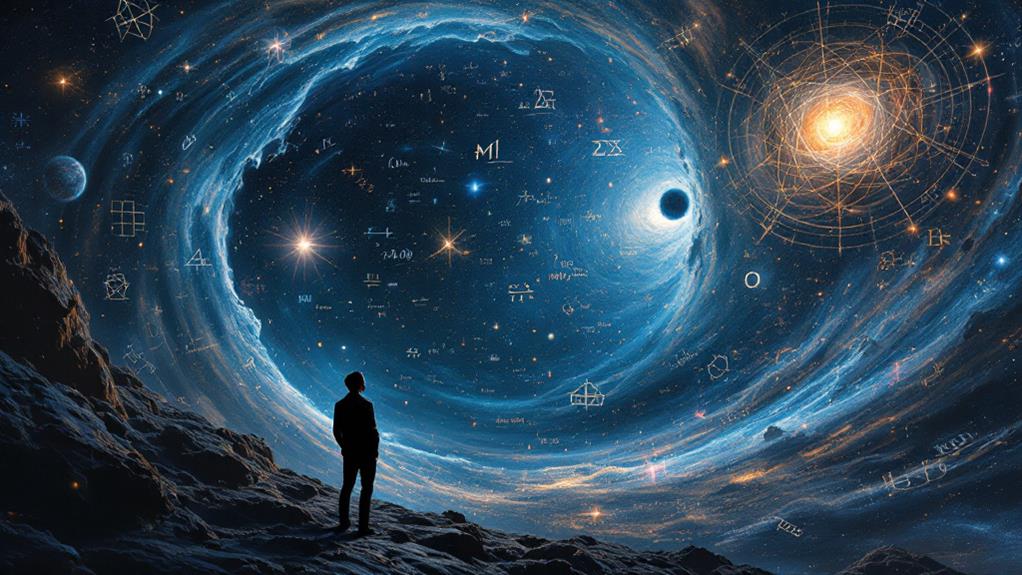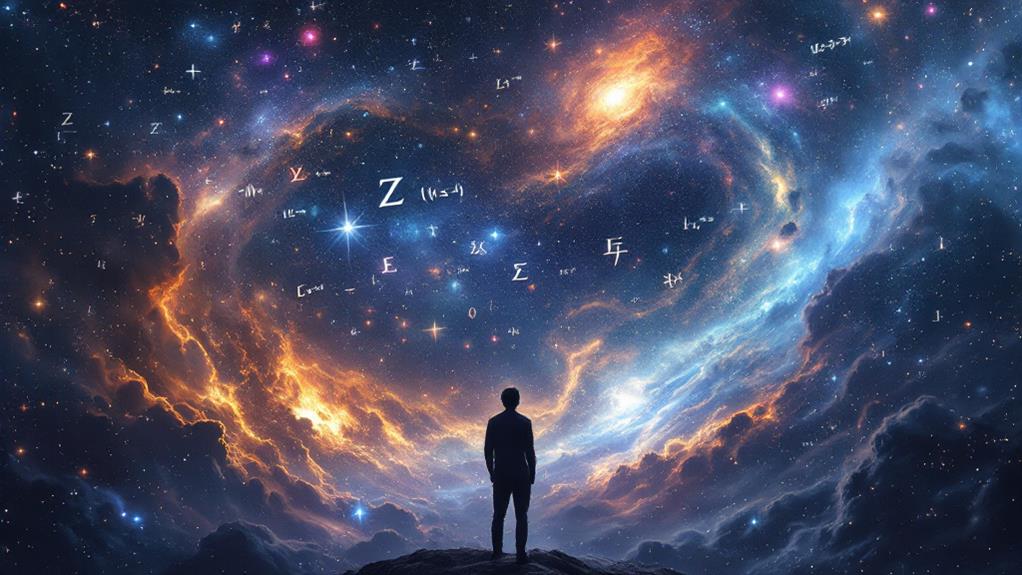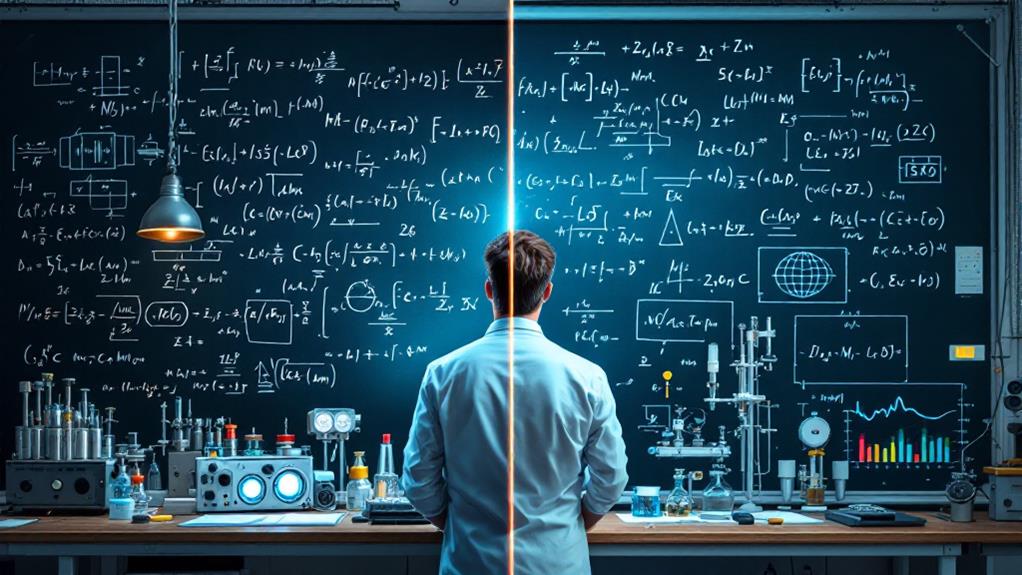What Is Theoretical Physics? Understanding the Science Behind the Universe

Theoretical physics is the branch of science that seeks to comprehend the fundamental laws governing our universe. It employs mathematical models and abstract concepts to elucidate observed phenomena and foretell new discoveries. You'll encounter key principles like quantum mechanics, relativity, and string theory, which investigate the nature of matter, energy, space, and time. From the tiniest subatomic particles to the vast expanse of the cosmos, theoretical physics aims to probe the enigmas of existence. It's a field that continually pushes the boundaries of human knowledge, challenging our grasp of reality. The venture into theoretical physics promises to unveil the intricate workings of our universe.
Origins of Theoretical Physics
Throughout history, theoretical physics has its roots in ancient civilizations' attempts to understand the natural world. You can trace its origins back to early Greek philosophers who sought to explain natural phenomena through logical reasoning rather than mysticism. These thinkers laid the groundwork for what would become modern scientific inquiry.
The historical development of theoretical physics gained momentum during the Renaissance and the Scientific Revolution. You'll find that this period saw a shift towards empirical observation and mathematical modeling. Scientists like Galileo and Newton revolutionized our understanding of motion and gravity, establishing the foundations of classical mechanics.
As you investigate further, you'll discover that the 19th and 20th centuries brought dramatic advances. Maxwell's equations unified electricity and magnetism, while Einstein's theories of relativity reshaped our conception of space and time. Quantum mechanics emerged, revealing the strange behavior of subatomic particles.
Today, theoretical physics continues to evolve, tackling questions about the universe's fundamental nature. From string theory to quantum gravity, you're witnessing ongoing efforts to unify all forces and particles into an inclusive paradigm.
Key Concepts and Principles
Foundations of theoretical physics rest on several key concepts and principles that guide scientific inquiry and explanation. You'll find that these abstract theories and interpretative models form the backbone of our understanding of the universe.
At the core of theoretical physics lies the scientific method, which emphasizes observation, hypothesis formation, and experimental validation. You'll encounter fundamental principles like conservation laws, symmetry, and relativity, which shape our understanding of nature's behavior.
Quantum mechanics introduces probabilistic interpretations of subatomic phenomena, while general relativity describes gravity as a curvature of spacetime. You'll grapple with concepts like wave-particle duality, uncertainty principle, and entanglement in quantum physics.
Field theories, such as quantum field theory and electromagnetism, explain how particles interact through force-carrying fields. You'll investigate unification theories that attempt to reconcile seemingly disparate forces of nature.
Statistical mechanics bridges microscopic and macroscopic phenomena, while thermodynamics governs energy transfer and transformation. You'll immerse yourself in concepts like entropy, phase changes, and emergent phenomena.
These key concepts and principles form the foundation upon which theoretical physicists build their understanding of the universe, constantly pushing the boundaries of human knowledge.
Quantum Mechanics Explained

At the heart of modern physics lies quantum mechanics, a theory that describes the behavior of matter and energy at the smallest scales. You'll find that this field challenges our everyday intuitions about how the world works. In quantum mechanics, particles can exist in multiple states simultaneously, a phenomenon known as superposition.
One of the most mind-bending concepts you'll encounter is wave-particle duality. This principle states that all matter and energy exhibit both wave-like and particle-like properties, depending on how you observe them. For instance, electrons can behave as particles in some experiments and as waves in others.
Another key aspect of quantum mechanics is quantum intertwining. This occurs when two particles become interconnected in such a way that the quantum state of each particle can't be described independently. Even when separated by vast distances, measuring one particle instantly affects the other.
You'll also come across concepts like the uncertainty principle, which states that you can't simultaneously measure a particle's position and momentum with perfect accuracy. These principles form the foundation of our understanding of the quantum world.
Relativity and Spacetime
While quantum mechanics deals with the microscopic world, Einstein's theory of relativity revolutionized our understanding of space, time, and gravity on a cosmic scale. You'll find that relativity introduces two key concepts: special relativity and general relativity.
Special relativity reveals that time and space are interconnected, forming a four-dimensional fabric called spacetime. It shows that the speed of light is constant for all observers and that time slows down for objects moving at high speeds.
General relativity takes this further, describing gravity as the curvature of spacetime caused by massive objects. You can think of spacetime as a flexible sheet that bends under the weight of planets and stars. This curvature explains why objects fall and planets orbit.
One of the most exciting predictions of general relativity is the existence of gravitational waves. These are ripples in spacetime caused by cataclysmic events like colliding black holes. Scientists have recently detected these waves, opening up a new way for you to observe the universe.
String Theory Basics

String theory often emerges as a leading candidate for a unified theory of physics. It proposes that the fundamental constituents of the universe are tiny, vibrating strings of energy. These strings, vibrating in different ways, give rise to all the particles and forces we observe in nature.
In string theory, you'll find that particles are no longer considered point-like, but rather one-dimensional cords. This concept helps resolve many of the inconsistencies between quantum mechanics and general relativity. The theory suggests that our universe may have more dimensions than the four we're familiar with - three spatial dimensions and time.
Quantum string interactions form the basis of how these strings behave and interact. Unlike traditional particle physics, string theory describes interactions through the splitting and joining of strings. This process is inherently probabilistic, leading to probabilistic string behavior. You'll notice that this aligns with the probabilistic nature of quantum mechanics.
String theory's mathematical structure is complex, requiring advanced concepts like supersymmetry and extra dimensions. While it's a sophisticated and promising theory, it remains challenging to test experimentally due to the incredibly small scale at which strings are thought to exist.
Particle Physics Fundamentals
How do the building blocks of our universe behave at the most fundamental level? Particle physics aims to answer this question by studying the smallest known constituents of matter and energy. At this scale, you'll encounter fascinating phenomena that challenge your everyday understanding of reality.
One of the most mind-bending concepts in particle physics is wave-particle duality. This principle states that all particles can exhibit both wave-like and particle-like properties, depending on how you observe them. It's a fundamental aspect of quantum mechanics that applies to electrons, photons, and even larger particles.
To describe the behavior of these quantum particles, physicists use mathematical tools like Schrödinger's equation. This powerful formula allows you to predict the probability of finding a particle in a specific state or location. It's essential for understanding atomic structure, chemical bonding, and many other quantum phenomena.
Particle physics also investigates the four fundamental forces: gravity, electromagnetism, strong nuclear force, and weak nuclear force. By studying how these forces interact with various particles, scientists can unravel the mysteries of our universe's composition and evolution.
Cosmology and the Universe

Exploring the cosmos on its grandest scale, cosmology seeks to understand the origin, evolution, and structure of the entire universe. As a branch of theoretical physics, it combines observations, mathematical models, and physical theories to explain the universe's behavior from the Big Bang to its ultimate fate.
You'll encounter fascinating concepts like dark matter, an invisible substance that interacts gravitationally with visible matter but doesn't emit light. Dark matter plays an indispensable role in galaxy formation and the universe's large-scale structure. Another key element in cosmology is the cosmic microwave background, a faint glow of radiation leftover from the early universe, providing meaningful insights into its composition and evolution.
Cosmologists study phenomena such as the expansion of the universe, the formation of galaxies and galaxy clusters, and the nature of dark energy – a mysterious force driving the universe's accelerating expansion. They also investigate the early universe's conditions, including inflation theory, which explains the universe's rapid expansion moments after the Big Bang. By combining observational data from telescopes, satellites, and particle detectors with theoretical models, cosmologists continue to refine our understanding of the universe's past, present, and future.
Mathematical Models in Physics
Physics' foundation rests on mathematical models that describe and predict natural phenomena. These models range from simple algebraic equations to complex differential equations that capture intricate relationships between physical quantities. You'll find that mathematical models are essential tools in theoretical physics, allowing scientists to formulate and test hypotheses about the universe's workings.
When you immerse yourself in theoretical physics, you'll encounter various mathematical techniques used to construct these models. Calculus, linear algebra, and tensor analysis are just a few examples of the mathematical frameworks employed. Differential equations, in particular, play a pivotal role in describing how physical systems change over time or space.
As technology advances, computational modeling has become increasingly important in theoretical physics. You can now use powerful computers to simulate complex physical systems and solve equations that were once thought unsolvable. This approach has revolutionized fields like quantum mechanics, fluid dynamics, and astrophysics.
Experimental Vs Theoretical Physics

The divide between experimental and theoretical physics represents two complementary approaches to understanding the universe. Experimental physics focuses on observing and measuring physical phenomena through carefully designed experiments. You'll find experimentalists using advanced equipment, collecting data, and applying sophisticated data analysis techniques to uncover nature's secrets. They're the hands-on scientists who build particle accelerators, design telescopes, and conduct laboratory tests to verify or challenge existing theories.
On the other hand, theoretical physicists work primarily with mathematical models and abstract concepts. They develop hypotheses, formulate equations, and predict outcomes based on existing knowledge. You'll often see them using computer simulations in experiments to test their ideas before real-world implementation. Theoretical physicists aim to explain observed phenomena and predict new ones that experimentalists can later investigate.
While these approaches may seem distinct, they're deeply interconnected. Experimental results inform and refine theoretical models, while theoretical predictions guide experimental design. This symbiotic relationship drives progress in physics, with each field challenging and supporting the other. As you explore deeper into physics, you'll appreciate how both experimental and theoretical approaches contribute to our understanding of the universe's fundamental laws.
Future Frontiers of Research
Peering into the future of theoretical physics reveals exciting frontiers of research. You'll find that emerging technologies are pushing the boundaries of what's possible in this field. Quantum computing, for instance, promises to revolutionize our ability to simulate complex physical systems and solve intricate mathematical problems.
As you investigate these frontiers, you'll encounter efforts to unify the fundamental laws of physics. Scientists are working tirelessly to reconcile quantum mechanics with general relativity, potentially leading to a theory of everything. This pursuit may disclose the secrets of dark matter, dark energy, and the early universe.
Another exciting area is the exploration of extra dimensions and multiverse theories. These concepts challenge our understanding of reality and could provide answers to long-standing questions about the nature of our universe.
You'll also see advancements in string theory and loop quantum gravity, which aim to describe the fabric of spacetime at the smallest scales. These theories may offer perspectives into the origin of the universe and the nature of black holes.



